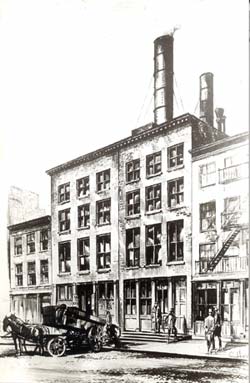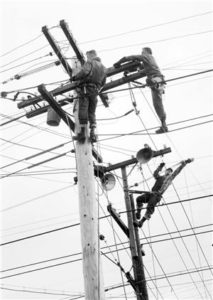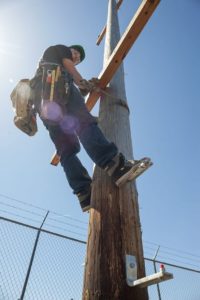How did those poles get there?
By Kevin Juhasz
For Huskie Tools
The American electrical system is an amazing accomplishment. Only 125 years ago, electricity was a new and luxurious item, and in less than a century, it’s grown into an incredible and essential system for nation.
Three interconnected grids comprised of 450,000 miles of power lines and 160,000 miles of overhead transmission lines bring power to the nation’s homes and businesses. Over 180 million wood, metal, and concrete poles, ranging in height from 30-120 feet, hold the above-ground wiring. Every year, those lines supply almost 4 trillion kilowatt-hours of power, enough to power 8 billion refrigerators in a single year.
About 4,000 different companies and more than 120,000 power linemen and thousands of others all work to keep the system going.
In the beginning
 Although experiments had been going on in America and other nations since the 1700s, America’s power system got its start in 1882 when J.P. Morgan provided Thomas Edison with funds to build the Pearl Street Station, the nation’s first commercial power plant. Its first customer was The New York Times. Buildings typically received their power from onsite generators. Pearl Street Station was a set of large generators that supplied power to customers via buried lines.
Although experiments had been going on in America and other nations since the 1700s, America’s power system got its start in 1882 when J.P. Morgan provided Thomas Edison with funds to build the Pearl Street Station, the nation’s first commercial power plant. Its first customer was The New York Times. Buildings typically received their power from onsite generators. Pearl Street Station was a set of large generators that supplied power to customers via buried lines.
Credit for the creation of the grid system, however, goes to Samuel Insull, who originally emigrated to the United States from England to work for Edison. He helped found the company that would eventually become General Electric, then left to head Chicago Edison. He grew the electric company and had almost exclusive rights to provide power to the city. He established two-tiered pricing that allowed him to offer affordable electricity to almost everyone. He also helped bring electricity to rural areas through high-powered transmission lines. He would eventually supply the majority of electricity to customers in 32 states.
Insull’s empire collapsed during the Great Depression, and he died in 1938 more than $14 million in debt. During his life, Insull fought for regulation of the industry as a counter to corrupt politicians who took bribes from electric companies to allow them to operate and not interfere with profitability.
It was during this time that linemen began its growth as a profession. Linemen had been around since the mid-1800s, but it was the growth of electricity that brought a boom to the career. Despite the dangers (more than a third of linemen were killed on the job), being a lineman meant a well-paying job. Part of the New Deal after the Great Depression was the expansion of electricity, which meant linemen could travel throughout the nation to get work.
Post-WWII 
Up until the 1950s, the primary use for electricity was for lighting. The introduction of new appliances, coupled with prosperity after the war, grew America’s need for more power. This is a trend that never changes. Even though there have been occasional dips in usage, Americans now use 12 times as much electricity today as they did in the 50s.
Because of the increase in the need for power in cities and suburbs, the life of the lineman became less nomadic. Many were able to settle down in an area to help provide electricity to growing suburban areas and help maintain the existing infrastructure.
Although linework has remained dangerous since its existence, and still remains in the top 10 most dangerous jobs, it became safer in the 1950s thanks to the establishment of apprenticeship programs and the rise of unions that began in the 1930s. There is also a greater emphasis on safety that still continues into this century.
The end of the 20th century
For much of its history, most electricity was generated thanks to burning coal. It was still the leader in the 70s, 80s, and 90s, but this time period also saw a rise in other sources and renewable energies. Coal is still second in electricity production, but natural gas is now the most used fuel source.
Nuclear and renewables now own a little less than 20 percent of the market each. Petroleum is rarely used today, except in remote areas. It was at the end of this period when solar and wind jumped to the lead as the most favored renewable energies. It was also one of the toughest periods for electricity supply as companies struggled to keep up with the demand.
This resulted in blackouts, brownouts, and other issues that led to changes in how power was supplied starting in the new millennium.
2000-Today
Being creatures of habit, humans have fallen into a pattern of how they use electricity. Power companies have begun to use this as a way to meet demand more efficiently. In the 2000s, companies began establishing methods to generate power form multiple methods and to increase supply as demand increases.
Today, there is a sustained effort to make appliances more energy efficient than they’ve ever been. The term “smart grid” was used officially for the first time in 2007, even though it started in the 1980s. In the latter part of the century, the U.S. Government made a commitment to the modernization of the electrical grid and started investing in it more in the interest of safety and security for the nation. Congress passed the Energy Independence and Security Act of 2007, several sections of which addressed the assessment of the nation’s smart grid system and invested in research and improvements. Since then, there have been several instances where additional funding has been made available under this act.
Today, lineworker jobs remain in high demand. Modernization, maintenance, and repair after disasters are more important than ever. Growth for electrical lineworkers remains strong even as demand for telecommunications line work decreases.
The dependence on electricity has never decreased. The term “worker” for these employees really understates their importance. They weren’t held in high enough regard in the early days of the career. With our dependence, lineworkers status has been raised to that of other first responders and many are heroes. That recognition is slowly growing, but still has a ways to go.
Electrifying moments in electricity
1752 – Ben Franklin’s famous kite-flying incident
1800 – Alessandro Volta creates the first electric battery
1840s – Lineworkers make their appearance after the invention of the telegraph
1852 – Lester Peyton creates the first watermill to generate electricity
1882 – Thomas Edison builds Pearl Street Station, America’s first power plant
1882 – The first hydroelectric power plant opens along the Fox River in Wisconsin
1891 - Nikola Tesla unveils his Tesla Coil and starts the famous Current Wars. Tesla’s AC would eventually win over Edison’s DC.
1887 – James Blyth builds the first windmill to generate electricity
1941 – Russell Ohl invents solar energy
1954 – The first nuclear power plant connected to a grid begins operations in the Soviet Union
1957 – The first nuclear power plant devoted solely to electricity generation opens in Pennsylvania
1977 – Lighting strikes leave 9 million people in New York City without power July 13-14. It’s one of the biggest blackouts in U.S. history
2000 – California experiences a year of power outages due to a shortage of power
2005 – Hurricane Katrina leaves 2.6 million people in six states without power
